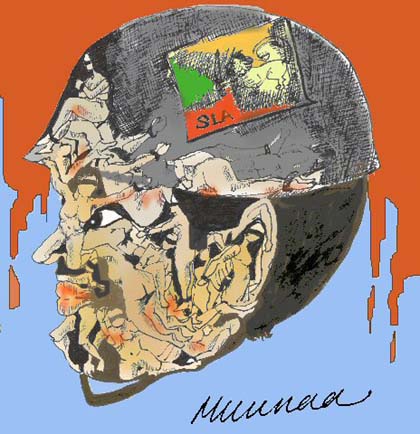 The recent publication of pictures of Balachandran Prabhakaran, hours before his execution, reiterates once again the brutality of Sri Lanka’s armed forces. The youngest son of the LTTE leader Vellupillai Prabhakaran was only one of thousands killed by the Sri Lankan army, but this execution was different from most other killings. The twelve year old was singled out and executed because he was seen as a representation of the Tamil national struggle. In killing him, the Sri Lankan army, was fulfilling its intention of materially destroying the Tamil struggle. Due to Balachandran’s significance there is also no doubt that the orders for his execution would have come from the very top: either the defence secretary Gothabaya Rajapakse or his brother, President Mahinda Rajapakse.
The recent publication of pictures of Balachandran Prabhakaran, hours before his execution, reiterates once again the brutality of Sri Lanka’s armed forces. The youngest son of the LTTE leader Vellupillai Prabhakaran was only one of thousands killed by the Sri Lankan army, but this execution was different from most other killings. The twelve year old was singled out and executed because he was seen as a representation of the Tamil national struggle. In killing him, the Sri Lankan army, was fulfilling its intention of materially destroying the Tamil struggle. Due to Balachandran’s significance there is also no doubt that the orders for his execution would have come from the very top: either the defence secretary Gothabaya Rajapakse or his brother, President Mahinda Rajapakse.
Balachandran did not represent a threat to Sri Lanka in any shape or form and would not have made a difference to Sri Lanka’s victory. Nothing was to be gained by the execution of this child. And yet, Balachandran was killed; shot five times at close range. It was an act imbued with momentous significance. In executing Balachandran, the Sinhala military was also annihilating the Tamils’ struggle and affirming to itself its complete dominance over the Tamil people. The Sri Lankan military’s abuses cannot be seen as individualised violations. Rather they are part of the state’s collective targeting of the Tamil population.
These acts are part of Sri Lanka’s on-going efforts to violently assert Sinhala supremacy over the Tamils. In November last year Jaffna students peacefully and privately observing a remembrance for the war dead were violently attacked. Following its victory, the Sri Lankan military has demolished war cemeteries and Prabakaran’s home. It also imprisoned his frail parents. After his mother died, Sinhala soldiers desecrated her remains. This zealous compulsion to destroy all aspects of Tamil nationalism means that it is impossible for Sri Lanka to come up with a satisfactory political solution satisfactory to on-going ethnic conflict.
The trophy photographs taken by Sinhalese soldiers have provided the international community with ample evidence of war crimes. Undoubtedly time will bring forth even more photographic evidence of yet more crimes. However, even as the international community takes steps to pressure Sri Lanka, the state is intent on causing irreversible damage to the Tamil nation through targeted killings, abductions, colonisation and land grabs by the Sinhala army.
Not only must the international community act decisively if it is to protect the Tamil population from systematic and on-going abuse, it must also understand and recognise the symbolic, targeted and collective nature of Sri Lanka’s crimes. This means moving beyond the individualised framework of human rights, and acknowledging that in targeting this or that individual Tamil, the Sri Lankan state seeks to ‘cower’, subdue and fragment the population as a whole. The point was underlined this week by Human Rights Watch’s UK Director David Mepham; describing the systematic rape of Tamil detainess as a coercive form of intimidation that was used as a “deliberate policy”, he said: “it is our view that this is not random [but] much more about installing fear and cowering this [Tamil] population.”
Sri Lanka’s preferred solution to the Tamil population is to violently erase the Tamil identity. In the wake of the images, unless unequivocal action is taken Sri Lanka will feel vindicated and emboldened in its current path and continue along it. This is what ‘time and space’ means for the Colombo government. If it is serious about peace and stability in Sri Lanka, the international community must act to arrest the slow genocide -the the 22nd UNHRC session and the Commonwealth Heads of Government Meeting in November are key opportunities in this regard. The Tamil nation, meanwhile, is unbowed, despite the horrors the Sri Lankan state continues to visit on it. In that sense Balachandran has become precisely what his murder was intended to prevent: a lasting reminder of why our resistance to Sinhala hegemony must be unrelenting and unending.